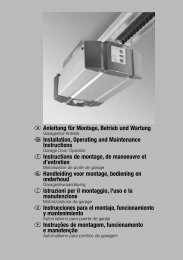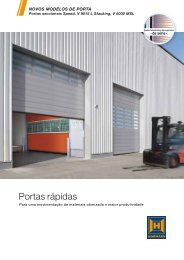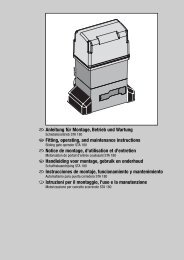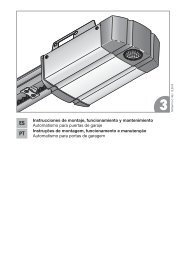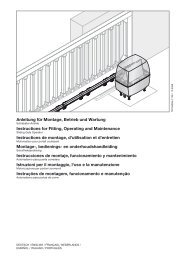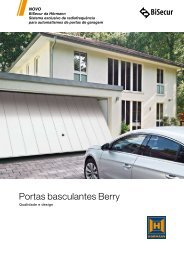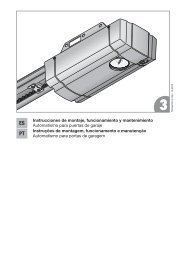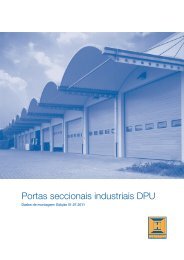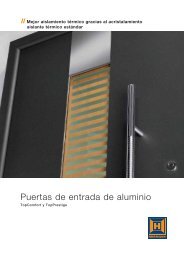Template BA B168xH238 - Hormann.be
Template BA B168xH238 - Hormann.be
Template BA B168xH238 - Hormann.be
You also want an ePaper? Increase the reach of your titles
YUMPU automatically turns print PDFs into web optimized ePapers that Google loves.
ENGLISH<br />
5. Check the final dimension by manually moving the gate<br />
into the end-of-travel positions while the operator is<br />
disengaged (see figure 2.4).<br />
6. Draw in the drill holes, remove the screw clamp, drill both<br />
holes and fix the linking bar fitting (see figure 2.5).<br />
3.3 Fitting the operator control<br />
WARNING<br />
Danger of injury due to unwanted<br />
gate travel<br />
Incorrect assembly or handling of the<br />
operator may trigger unwanted gate<br />
travel that may result in persons or<br />
objects <strong>be</strong>ing trapped<br />
▶ Follow all the instructions provided<br />
in this manual.<br />
Incorrectly attached control devices<br />
(e.g. buttons) may trigger unwanted gate<br />
travel. Persons or objects may <strong>be</strong><br />
trapped as a result.<br />
▶ Install control devices at a height of<br />
at least 1.5 m (out of the reach of<br />
children).<br />
▶ Fit permanently installed control<br />
devices (such as buttons) so that<br />
the entire area of travel of the gate<br />
is visible, but they are still away<br />
from moving parts.<br />
Persons or objects may <strong>be</strong> trapped if the<br />
installed safety equipment fails.<br />
▶ In accordance with BGR 232, install<br />
at least one clearly visible and easily<br />
accessible emergency command<br />
unit (emergency OFF) near the gate<br />
so the gate can <strong>be</strong> brought to a<br />
standstill in the case of danger<br />
(see section 7.3.3)<br />
WARNING<br />
Danger of injury due to unexpected gate travel<br />
Unexpected gate travel can result when the emergency<br />
battery is still connected despite the mains plug <strong>be</strong>ing<br />
pulled out.<br />
▶ Pull out the mains plug and the plug of the emergency<br />
battery when performing all work on the gate system.<br />
ATTENTION<br />
Moisture<br />
Penetrating moisture may damage the control.<br />
▶ Protect the control from moisture when you open the<br />
control housing.<br />
To fit the operator control:<br />
1. Loosen the four screws to remove the cover on the<br />
operator control.<br />
2. Fit the four feet on the operator control (see figure 3.1).<br />
3. Fit the operator control as shown in figure 3.1.<br />
3.3.1 Fixing the warning sign<br />
Fix the sign warning about getting trapped in a noticeable<br />
place or near the permanently installed operator buttons.<br />
▶ See figure 4<br />
3.4 Mains voltage<br />
Mains voltage<br />
Danger<br />
Contact with the mains voltage presents the danger of a<br />
deadly electric shock.<br />
For that reason, observe the following warnings under all<br />
circumstances:<br />
▶ Electrical connections may only <strong>be</strong> made by a qualified<br />
electrician.<br />
▶ The on-site electrical installation must conform to the<br />
applicable protective regulations (230/240 V AC,<br />
50/60 Hz)!<br />
▶ Ensure that the national regulations governing the<br />
operation of electrical equipment are complied with.<br />
▶ Before undertaking any electrical work, disconnect the<br />
system from the mains supply and ensure that it<br />
cannot <strong>be</strong> inadvertently turned on.<br />
ATTENTION<br />
External voltage on the connecting terminals<br />
External voltage on the connecting terminals of the control<br />
will destroy the electronics.<br />
▶ Do not apply any mains voltage (230/240 V AC) to the<br />
connecting terminals of the control.<br />
To prevent malfunctions:<br />
▶ The connection cables of the operator (24 V DC) must <strong>be</strong><br />
laid in a separate installation system from the other<br />
supply cables (230 V AC).<br />
▶ If laying cables in the ground, use an underground cable<br />
(NYY) for all cables (see figure 3).<br />
▶ If laying cables in the ground as an extension, the<br />
connection to the control cables must <strong>be</strong> in a spraywater<br />
protected junction box (IP 65, to <strong>be</strong> provided on<br />
site).<br />
▶ All the cables must <strong>be</strong> inserted into the control unit from<br />
<strong>be</strong>low and free from distortion.<br />
3.5<br />
Connecting the operators<br />
▶<br />
▶<br />
▶<br />
The operator control must <strong>be</strong> fit vertically and with the<br />
cable fixings towards the bottom.<br />
To retrofit cable fixings, punch through the pre-stamped<br />
break points, making sure that the cover is closed first.<br />
The length of the connection cable <strong>be</strong>tween the operator<br />
and control may <strong>be</strong> max. 40 m.<br />
3.5.1 Operator connection with a single-leaf gate<br />
system<br />
Fit the operator cables to the leaf A plug as shown in<br />
figure 5.2.<br />
3.5.2 Operator connection with a double-leaf gate<br />
system without threshold<br />
▶ See figure 5.3a<br />
Connect the leaf that opens first or the traffic leaf to the leaf A<br />
plug. The operator cable for the other leaf is connected to the<br />
32 TR10A078 RE / 07.2010





